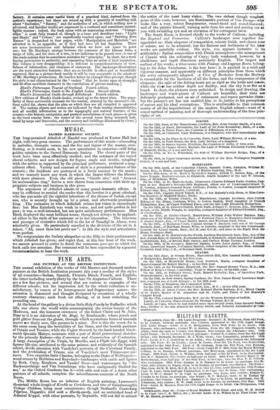FINE ARTS.
OLD PICTURES AT THE BRITISH INSTITUTION.
THE annual exhibition of the works of Old Masters and deceased modern painters at the British Institution presents this year a medley of the styles of all countries—Italian, Spanish, Flemish, Dutch, French, and English; the latter including nearlythirty by the late Sir Augustus Callcott. There are a few fine pictures, and several that are curious as examples of the different schools; but the impression left by the whole collection is un- satisfactory, by reason of its heterogenous and fragmentary nature: the attention is distracted and thought dissipated by sensations of a wholly contrary character; each fresh set effacing, or at least enfeebling, the preceding one.
At the head of the gallery is a divine little Holy Family by Raffaelle; which lifts one above the world while contemplating the serene beauty of the Madonna, and the innocent sweetness of the Infant Christ and St. John. Near to it is an Adoration of the Magi, by Rembrandt; where jewels and gold glitter from out the gloom, through which mysterious forms of uncouth aspect are dimly seen, like gnomes in a mine. Nor is this the worst; for in the same room hang the bestialities of Ian Steen, and the boorish pastimes of Ostade and Teniers; while the Unjust Steward, by the bard-handed black- smith Quentin Matsys, contrasts with a pair of florid processional sketches by the princely Rnbens—the Conversion and Consecration of Constantine. A large Assumption of the Virgin, by Murillo, and a Flight into Egypt, with figures life-size, attributed to the same painter, and evidently of the Spanish school, divide attention with Vandyke's portraits of the Cleveland Family, and the Archbishop of Trieste, one of Vandyke's most Titianesque pic- tures. Two exquisite little Claudea, belonging to the Duke of Wellington- wood-scenes by Hoblima and Ruysdael—landscapes with cattle and figures by Both, Cnyp, Berghem, and Vander Neer—and waterscapes by " the Backsomethings and Van Somethings who have malignantly libelled the sea," as- the Oxford Graduate has it—with odds and ends of a dozen other painters of all schools, complete the miscellaneous contents of the North Room.
The Middle Room has an infusion of English painting; Lawrence's theatrical whole-length of Kemble as Coriolanus, and two of Gahisborough's Cottage Children, being most conspicuous; though Stothard's Canterbury Pilgrims, Hogarth's Girl with a Hurdy-gurdy, and an unfinished head of Admiral Keppel, with other portraits, by Reynolds, will not fail to attract the notice of the most hasty visiter. The two richest though roughed gems of this room, however, are Rembrandt's portrait of Van Trots who looks like a rosy, robust Burgomaster, round-faced and round-featured; and of the painter himself,turning aside from his easel and peering out at you with twinkling eye and an elevation of his corrugated brow. The South Room is devoted chiefly to the works of Callcott; including the Raphael and Fornarina. Callcott's landscapes seen together dis- appointed us: their elegance of composition, minute finish, and chaste tone of colour, are to be admired; but the flatness and feebleness of his late- works are painfully evident. His style, too, appears imitative in its artificiality: Italian composition with Dutch atmosphere—the arrangement of Claude with the colouring of Cnyp; both weakened, however, by a chalkiness and vapid flimsiness peculiarly English. The largest and earliest of his works, a river-scene with Passage and Luggage Boats, belong- ing to Sir John Swinburne, is the best here: it is painted in a solid and vigorous manner, and apparently on different principles from those which the artist subsequently adopted. A View of Rochester from the Medway is remarkable for the hardness of all the forms, and the evanescence of the; elements: the sails of the fishing-boats are as rigid as the hulls and masts; while the river has neither depth nor fluidity, and the sky is as flat as a board. In short, the pictures seem unfinished. In design and drawing, the- landscapes and water-pieces of Callcott are beautiful; their tints are delicately graduated, and an air of refinement and repose pervades them: but the painter's art has not enabled him to do justice to his perceptions of nature and his ideal conceptions. This is attributable to that common source of all the imperfections of the modern English school—want of a sound method of painting, and of thorough understanding of the true prin- ciples of art.


























 Previous page
Previous page